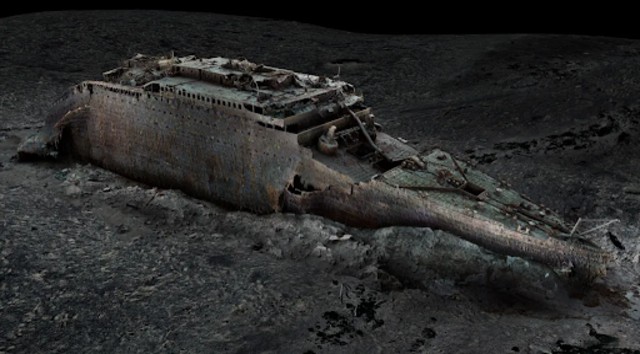
The digital scan shows the front part of the Titanic resting straight on the ocean floor. BBC
A new 3D scan of the Titanic wreck has revealed striking details about the ship’s final moments before it sank in 1912. Over 1,500 people died in the disaster after the ship hit an iceberg in the North Atlantic. This new scan gives a never-before-seen view of the wreck, bringing fresh understanding of the tragedy.
The digital scan shows the Titanic in full for the first time. It used over 700,000 images taken by underwater robots to form a complete model. The bow of the ship lies upright on the ocean floor, while the stern sits 600 meters away, crumpled and twisted from the force of impact.
One of the biggest discoveries is the state of the boiler rooms. The scan shows bent boilers and an open steam valve, proving engineers worked to keep the lights on until the very end. This supports accounts from survivors who said the ship stayed lit as it sank. These engineers, led by Joseph Bell, sacrificed their lives to help others escape.
Experts found a porthole with broken glass, possibly caused by the iceberg scraping the ship. This matches survivor stories that say chunks of ice entered some cabins. The scan also shows rust and decay on the hull, as sea life continues to eat away at the wreck.
The stern tells a different story. It is badly mangled from spinning during the sinking and crashing into the sea floor. Among the twisted metal, the scan captured a valve stuck in the open position, hinting that power systems were still active as the stern went under.
A team of scientists also ran a new simulation of the sinking. Using the ship’s blueprints and movement data, they recreated the damage caused by the iceberg. Their model shows that the ship didn’t hit the iceberg head-on. Instead, it suffered several small gashes along one side of the hull. Each hole was about the size of an A4 sheet of paper. Though tiny, they let water flood six compartments. The ship was only built to survive flooding in four.
According to researchers, this narrow line of holes sealed Titanic’s fate. As each compartment filled, water slowly poured over into the next. The ship couldn’t stay afloat. The bottom of the bow, which might hold more signs of the damage, is buried under the sea floor and can’t be seen on the scan.
Personal items still lie scattered across the ocean bed, reminders of the lives lost. The ship may be silent, but experts say it still has stories to share.
The full scan is being closely studied by researchers. It may take years to explore every detail. But with each discovery, we get a clearer picture of what happened on that cold night in 1912.















